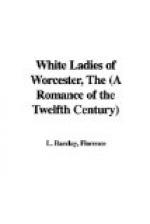“The little foolish bird,” said the Bishop—and he spoke in that gently musing tone, which conveys to the mind of the hearer a sense of infinite leisure in which to weigh and consider the subject in hand—“The little foolish bird might soon wish herself back in the safety of the cage. On such as she, the cruel hawks of life do love to prey. Absorbed in the contemplation of her own charms, she sees not, until too late, the dangers which surround her. Such little foolish birds, my daughter, are best in the safe shelter of the cloister. Moreover, of what value are they in the world? None. If Popinjays wed them, they do but hatch out broods of foolish little Popinjays. If true men, caught by mere surface beauty, wed them, it can mean naught save heartbreak and sorrow, and deterioration of the race. Women of finer mould”—for an instant the Bishop’s eyes strayed from the sunset—“are needed, to be the mothers of the men who, in the years to come, are to make England great. Nay, rather than let one escape, I would shut up all the little foolish birds in a Nunnery, with our excellent Sub-Prioress to administer necessary discipline.”
With his elbows resting upon the arms of the chair, the Bishop put his fingers together, so that the tips met most precisely; then bent his lips to them, and looked at the Prioress.
She, troubled and sick at heart, lifting deep pools of silent misery, met the merry twinkle in the Bishop’s eyes, and sat astonished. What was it like? Why it was like the song of a robin, perched on a frosty bough, on Christmas morning! It was so young and gay; so jocund, and so hopeful.
Meeting it, the Prioress realised fully, what she had many times half-divined, that the revered and reverend Prelate sitting opposite, for all his robes and dignity, his panoply of Church and State, had the heart of a merry schoolboy out on a holiday.
For the moment she felt much older than the Bishop, infinitely sadder; more travel-worn and worldly-wise.
Then she looked at the silver hair; the firm mouth, with a shrewd curve at either corner; the thoughtful brow.
And then she looked at the Bishop’s ring.
The Bishop wore a remarkable ring; not a signet, but a large gem of great value, beautifully cut in many facets, and clear set in massive gold. This precious stone, said to be a chrysoprasus, had been given to the Bishop by a Russian prince, in acknowledgment of a great service rendered him when he came on pilgrimage to Rome. The rarity of these gems arose partly from the fact that the sovereigns of Russia had decreed that they should be held exclusively for royal ornament, forbidding their use or purchase by people of lesser degree.
But its beauty and its rarity were not the only qualities of the precious stone in the Bishop’s ring. The strangest thing about it was that its colour varied, according to the Bishop’s mood and surroundings.




